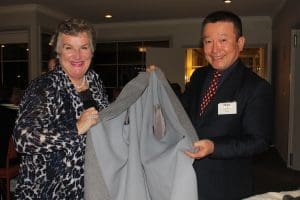
Southern Grampains mayor Cr Mary-Ann Brown is shown a Hamilton Lambswool jacket by Itochu’s Masafumi Kuritani.
SUPERFINE wool growers have been urged to keep skin out of lambs wool by major Japanese processor Itochu Corporation.
At the recent Australian Superfine Wool Growers Association re-union dinner at Hamilton in Victoria Itochu Corporation representative Masafumi ‘Mike’ Kuritani showed producers how small pieces of skin could spoil valuable Hamilton Lambswool fabric.
Itochu launched its Hamilton Lambswool brand in its first wool collection for 2015/16 Autumn/Winter season in December 2014 at the Australian Embassy in Tokyo.
Mr Kuritani is an honorary life member of the ASWGA and has been associated with the Australian wool industry since 1987 when he was sent here to gain experience. Products coming from the Itochu pipeline have included Geelong Lambswool sweaters, Tasmanian Merino suitings, fine handknitting yarn, and Bluewool suiting.
Click here to get the latest Sheep Central story links sent to your email inbox.
Mr Kuritani gave thanks for the quality of the wool coming from the Hamilton area, but he said the company could not handle skin contamination in the raw fibre, although the contamination indicated that the wool was genuine lambs wool. He said most lambswool sweaters were not made from lambs wool, but from pieces or premature shorn fleece.

AME buyer Andrew Worthington holds knitted fabric contaminated with skin pieces.
However, small pieces of skin could be spread through the fabric during the carding process. Mr Kuritani and Australian Merino Exports buyer Andrew Worthington showed growers at the dinner how pieces of skin could spoil lambs wool fabric by taking dye differentially, becoming a problem with consumers.
“If we dye in red it (the skin pieces) becomes dark red and if we dye in pink it becomes a red spot.
“I sincerely request your help to minimise skin contamination in the lambs fleece at the time of shearing.”
ASWGA Hamilton branch president David Rowbottom supported Mr Kuritani and said skin pieces were best removed on the board before the fleeces was put on the wool table.
He said he had arguments with wool handlers who think “a little bit of skin was OK.”
“But it is obviously not and we need to get every bit out and if we want big money for our wool, if we expect the big mills to pay good money for their wool we’ve got to do the right thing and keep skin out.
“I can’t emphasise it enough.”
Mr Rowbottom said dog hair was also a big “no no”.
“Dog hair is a disaster as well and there have been times where it has created a major disaster in some cloth.”



Very refreshing and unprecedented to hear such honesty from a buyer and processor such as Mike Kuritani. First on May 18 2017, he explained that “the Japanese were undeterred by the doubling price of wool.” And now, “most lambs wool sweaters were not made from lambs wool, but from pieces or prematurely shorn fleece.” No great surprise there, except for his honesty. Has anyone ever seen any garment branded as, ” made from pieces”?
So where does the lambs wool go? It is known that all 16-17 micron fleece — lambs and out-sorts including locks — can be blended into cashmere and mohair lines and sold as such. I know of an Australian manufacturer who blended fine crossbred crutchings into “pure lambs wool” blankets. Every processor has their own tricks and for growers to get honest feedback from mills is rubbish, as obviously as bales are scoured in large batches; all identity is lost.